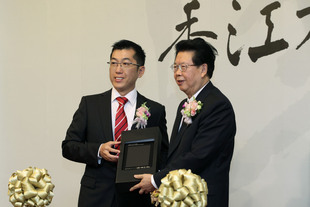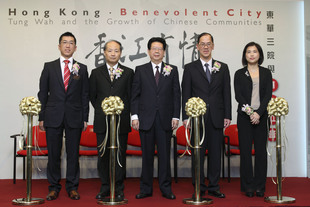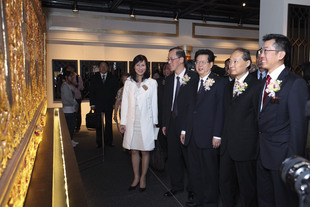Exhibition shows history of Tung Wah Group of Hospitals
A new exhibition entitled “Hong Kong, Benevolent City: Tung Wah and the Growth of Chinese Communities”, celebrating the 140th anniversary of the Tung Wah Group of Hospitals, will be held at the Hong Kong Museum of History from 27 October 2010 until 17 January 2011.
The exhibition is jointly presented by the Leisure and Cultural Services Department and Tung Wah Group of Hospitals, and organised by the Museum of History and the Tung Wah Museum. Featuring 250 valuable artefacts, the exhibition will introduce visitors to Tung Wah’s services in the areas of medical care, disaster relief, education, social services, bone repatriation of overseas Chinese and heritage conservation. By attending the exhibition the public will come to understand the contribution made by the Tung Wah Group of Hospitals over the years, and the pivotal role played by Hong Kong in uniting Mainland and overseas Chinese.
The exhibition was officially opened on 26 October 2010 by the Member of the Standing Committee of the National Committee of CPPCC, and Chairperson of the Committee for Learning and Cultural and Historical Data of the National Committee of CPPCC, Mr. CHEN Fujin; the Deputy Commissioner of the Commissioner’s Office of China’s Foreign Ministry in the Hong Kong Special Administrative Region, Mr. ZHAN Yongxin; the Secretary for Home Affairs, Mr. TSANG Tak-sing, GBS, JP; the Chairman of the Tung Wah Group of Hospitals, Mr. Billy LEUNG Ting-yu; and the Director of Leisure and Cultural Services, Mrs. Betty FUNG CHING Suk-yee, JP.
Speaking at the opening ceremony, Mr. Tsang said that the Tung Wah Group of Hospitals, established in 1870, had 140 years of history and was Hong Kong’s longest-standing and largest charitable organisation. In the past 100 years or so, the hospitals, schools and various social groups under the management of Tung Wah, have provided a diverse range of services for the people of Hong Kong.
Mr. Tsang said that the Tung Wah Museum, which was set up 40 years ago, had enabled the Tung Wah Group to preserve its valuable relics. In recent years, it has revealed its historical records to the public, as well as organising and compiling its archives for publishing. These invaluable historical documents will be on display at the exhibition to give visitors an opportunity to learn more about the changes that the Tung Wah Group of Hospitals went through along with Hong Kong.
Soon after taking control of Hong Kong Island, the colonial government was wary of Chinese people and control was exercised through segregation. As China opened its coastal cities to foreign trade in the 1860s, maritime transportation grew and local Chinese increased their collective affluence. The founding of Tung Wah Hospital in 1870 was a milestone for Hong Kong’s Chinese community. Directors of the Hospital, who were all established businessmen, served as mediators between local Chinese and the Hong Kong Government. They also received Mainland government officials visiting Hong Kong, took part in charity and relief work, and liaised with the Chinese Government.
In the mid-19th century, Hong Kong had few hospitals, largely because many Chinese resisted western medical treatment. After the bubonic plague of 1894, Tung Wah Hospital, which was established to preserve the tradition of Chinese medical services, began to introduce a resident western medical programme and submit itself to regular inspection by government doctors. Entering the 20th century, Chinese attitudes towards Western medicine gradually became more accepting. When the Kwong Wah Hospital was founded in 1911 and the Tung Wah Eastern Hospital in 1929, they were equipped with Western medical equipment. In 1931, the three hospitals were amalgamated into the Tung Wah Group of Hospitals and drew up long-term development plans for healthcare. During this period the group recorded remarkable achievements in terms of hospital expansion and the improvement of existing facilities.
Tung Wah’s earliest disaster relief work occurred in the aftermath of the typhoon that struck Hong Kong in 1874. The typhoon caused heavy casualties, and subsequently Tung Wah regularly participated in disaster relief work in Hong Kong, the mainland and overseas. Qing emperor Guangxu bestowed tablets on Tung Wah commending their kindness and generosity in extending a helping hand by zealously raising disaster relief funds for the severe drought in North China between 1876 and 1879, and for the flooding in Guangdong province in 1885. After the outbreak of the Sino-Japanese War in 1937, Tung Wah opened a temporary shelter that received over 30,000 immigrants, managing refugee camps and providing food for those in need. Tung Wah also assisted with refugee repatriation and greatly eased the Government’s task of helping them settle.
In the late 19th century, the remains of Chinese who died overseas were returned to the Mainland via Hong Kong, where they would be kept temporarily in a coffin. Tung Wah established the Slaughter House Cemetery in Kennedy Town soon after its founding and later took over the coffin home next to the cemetery. The construction of the Tung Wah Coffin Home in 1899 thus bore witness to the complex history of Chinese people abroad. Through the large amount of literature preserved by the Coffin Home, it has been possible to reconstruct many of the close connections between Tung Wah and overseas Chinese, including links with commercial, charitable, village, town and clan associations in Mainland China.
In the early years of Hong Kong’s opening up to foreign trade, many Chinese children were deprived of schooling. Consequently, the general committee of the Man Mo Temple began discussions on founding a free school in 1879. The school that eventually came of this vision was taken over by the Tung Wah in 1880. From 1910, the free schools gradually evolved into modern institutions of learning and in 1961, Tung Wah established its first secondary school. Since the 1980s, Tung Wah has established kindergartens, special and vocational schools as well as pre-vocational training programmes to provide comprehensive education services to children and teenagers. In recent years, Tung Wah has also begun offering associate degree programmes at its Community College.
Tung Wah has always placed strong emphasis on conserving, researching and organising its own history. Given the massive loss of pre-war government documents in Hong Kong, Tung Wah’s well preserved written records played a key part in providing an understanding of Hong Kong’s pre-war development. In 1970, it revitalised the old Main Hall Building of the Kwong Wah Hospital and converted it into the Tung Wah Museum, where the group’s relics are stored and on display. In 2003, restoration of the Tung Wah Coffin Home was completed at a cost exceeding $10 million. The project won two heritage restoration awards.
Over the years, Tung Wah has evolved from a local charity to a modern non-governmental organisation. Today, it operates 223 services units and employs a work force of over 10,000 people, providing comprehensive and well-integrated medical, education and social services for the community.
The exhibition will enable the public to learn more about the development of the Tung Wah Group of Hospitals as well as social changes in Hong Kong over the past 100 years through the 250 artefacts on display, including invaluable tablets, documents and historical pictures.
To tie in with the exhibition, a series of lectures, workshops and school activities will be organised. For details, please contact 2724 9080, 2724 9082 or 2724 9057. In addition, a fully illustrated catalogue will be published and available at the gift shop in the Museum of History.
The Museum of History is located at 100 Chatham Road South, Tsim Sha Tsui, Kowloon. It opens from 10am to 6pm from Monday to Saturday, and from 10am to 7pm on Sundays and public holidays. It is closed on Tuesdays (except public holidays). Admission to the museum is $10 and a half-price concession is available for full-time students, senior citizens and people with disabilities. Admission is free on Wednesdays.
For details of the exhibition, please visit the Museum of History’s website at http://hk.history.museum or call 2724 9042.
* End *
For media enquiries, please contact Ms. Ivy LAU, Principal Corporate Communications Manager, at 2859 7853.

Mr. Billy LEUNG (left), Chairman of Tung Wah Group of Hospitals, presenting a souvenir to Mr. CHEN Fujin, Chairperson of the Committee for Learning and Cultural and Historical Data of the National Committee of CPPCC.

(From left) Mr. Billy LEUNG, Chairman of Tung Wah Group of Hospitals, Mr. ZHAN Yongxin, Deputy Commissioner of the Commissioner’s Office of China’s Foreign Ministry in the Hong Kong Special Administrative Region, Mr. CHEN Fujin, Chairperson of the Committee for Learning and Cultural and Historical Data of the National Committee of CPPCC, Mr. TSANG Tak-sing, GBS, JP, Secretary for Home Affairs, and Mrs. Betty FUNG CHING Suk-yee, JP, Director of Leisure and Cultural Services, officating at the ceremony of “Hong Kong, Benevolent City: Tung Wah and the Growth of Chinese Communities” exhibition.

A Tung Wah student introducing artefacts to Mr. CHEN Fujin (left) and Mr. Billy LEUNG.

Guests visiting the “Wan Wu Xian Li” tablet bestowed by Qing Emperor Guangxu.



